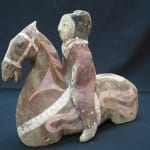A Pair of Han Dynasty Painted Pottery Seated Horses with Detachable Riders, 206 BCE - 220 CE
Terracotta
26.9 x 22.9 cm
10 5/8 x 9 in
10 5/8 x 9 in
DL.2068
The impact of the horse on the history of China cannot be underestimated. In fact, the ancient unification and expansion of the Chinese Empire was due in large part to...
The impact of the horse on the history of China cannot be underestimated. In fact, the ancient unification and expansion of the Chinese Empire was due in large part to this majestic creature. Their rapid mobility enabled quick correspondence between far away provinces, allowing the establishment of a centralized power. Likewise, the military role of horses aided in the conquest and submission of distant lands. The influence of the horse on the history and culture of China can be viewed, in part, through the artistic legacy of this great civilization. Believed to be relatives of mythological dragons, a theory reflecting their sacred status, horses were glorified and revered in sculpture, painting, and literature. During the unification of China under the Han Dynasty, bands of mounted nomadic warriors from the north threatened the country. In order to thwart their attacks, the Chinese imported stronger, faster steeds from Central Asia (as opposed to the native Mongol ponies) eventually leading to the creation of the Silk Road. During the Han Dynasty, the horse was rendered in miniature sculptural form specifically in order to be interred with the dead. It was believed that the sculpted version could assume the powers of its living counterpart in the afterlife and assist the deceased in the dangerous journey to the next world. This custom catered to the needs of a particular belief system regarding life after death and the spiritual world.
This pair of polychromed horses are remarkable for the survival of their detachable riders. The horses themselves are adorned with white reins and an elegant purple ribbon-like motif. The figures retain much of their original colouring and their facial features are clearly distinguishable. Although the hands have been lost, the riders are in excellent overall condition. The care lavished on this charming pair reminds us of the respect that these animals commanded during the Han Dynasty.
This pair of polychromed horses are remarkable for the survival of their detachable riders. The horses themselves are adorned with white reins and an elegant purple ribbon-like motif. The figures retain much of their original colouring and their facial features are clearly distinguishable. Although the hands have been lost, the riders are in excellent overall condition. The care lavished on this charming pair reminds us of the respect that these animals commanded during the Han Dynasty.



